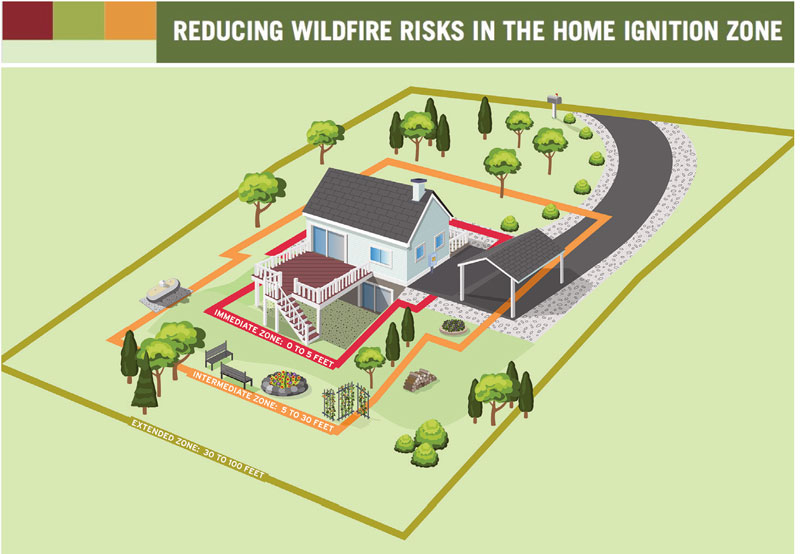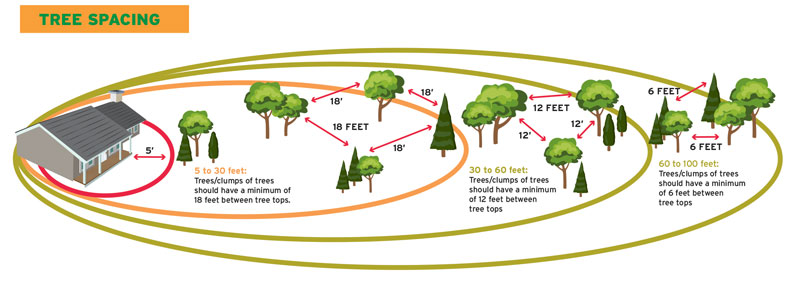8/1/2021
Wildfire Season: Landscapes That Save Homes
Jennifer Duffield White

When an intense crown fire rages through a forest, it’s hard to fathom that a stone path or a well-pruned tree could be the difference between a home burning to the ground or remaining unscathed. But as another wildfire season marks the U.S. with a mosaic pattern of burned and unburned homes, it’s a good time to remind homeowners that while they can’t put out the wildfire themselves, they aren’t powerless either. Their home landscape has an influence on whether or not a house will burn.
Before your customers tear out all signs of life in their yard, give them the tools to do it right. Yes, they can have it all: a beautiful landscape with plants and a fire-wise landscape.
How Houses Burn
In the U.S., we suppress and control a lot of wildfires with an initial response (about 95% to 98% of fires), but 2% to 5% of the time, it just doesn’t work because of extreme conditions—among those are the extreme fires that make history and often threaten homes. In these extreme fires, one might assume that home protection is a lost cause. But here’s the humdinger: when researchers look at the patterns of home destruction during extreme wildfires, it’s typically embers or smaller, low-intensity surface fires that lead to a home’s ultimate ignition and destruction.
In “An Analysis of Wildland-Urban Fire with Implications for Preventing Structure Ignitions,” Jack Cohen, Ph.D, a retired scientist with the U.S. Forest Service, writes, “Most home ignitions occur from sources within a home’s immediate surroundings, not a tsunami of wildfire flames flowing through a residential area.”
That’s because roads and home developments often slow down that wall of flames running through the tops of trees, which is known as a crown fire. Instead, housing is more at risk from the flying embers and small ground fires that work through the property. That means building materials and landscaping can have a dramatic impact on how susceptible a home will be to being damaged.
Of course, nothing is a guarantee; fire is a complex beast, but with some fire-wise landscaping decisions, your customers can rest a little easier knowing that they’ve done the right things to protect their home.
Another reason to pursue fire-wise landscapes? If a fire engine crew has the opportunity to protect structures in a neighborhood, they’re more likely to choose homes with defensible spaces: ones that maybe have some fuel breaks, well-pruned trees and no dead or dried-up vegetation.
The Basics of Defensible Space
When it comes to landscaping, it’s all about the distance from any exterior of the home, keeping things grouped in small clusters and islands, and breaking up the available fuel so a ground fire can’t reach the house.
It should be noted: there are important non-landscaping things that can make a home’s exterior more fire resistant, such as cleaning gutters, screening under decks and over vents, and building materials. But for Green Profit readers, we’ll focus on the landscaping aspect.
When experts in fire and home protection discuss hardening a home, they talk about the “home ignition zone” and break it up into three zones.
Immediate Zone: 0 to 5 ft. from the home exterior
This zone is the most vulnerable to embers, and thus, if you need to focus on just one zone, this is the one. You want to avoid flammable materials in this zone. Most organic-based mulches are flammable to varying degrees (see below). Avoid or remove these; instead, go for nonflammable mulches such as rocks. Avoid flammable plants, leaves and needles in this zone. (And, yes, get those piles of firewood and overhanging branches out of this zone.)
Intermediate Zone: 5 to 30 ft. from the home exterior
Here’s where you can get creative with landscaping and hardscaping to create fire breaks around the home. If low flames or an ember ignite in this zone, driveways, paths, patios and rocks can stymie a ground fire’s advance. Keep vegetation in small clusters/islands, with appropriate spacing, and use nonflammable hardscaping to break up vegetation.
In this zone, keeping things “trimmed” is essential. Lawns and native grasses should be kept to a height of 4 in. or less. This is also a danger zone for any ladder fuels that might allow a ground fire to creep up into the tops of trees and cause more severe fire behavior. Trim or remove these ladder fuels. For taller trees, prune them 6 to 10 ft. from the ground. For shorter trees, don’t prune more than 1/3 of the overall tree height.
Tree spacing can also make a big difference. Trees should have a minimum of 18 ft. between crowns and the canopy should be at least 10 ft. from any structure.
Extended Zone: 30 to 100 ft. from the home exterior
In this zone, the goal is to use landscaping to interrupt a fire’s path and to keep flames small and on the ground. That means removing dead plant and tree material, making sure there isn’t a lot of debris on the ground and keeping tree spacing reasonable.
The National Fire Protection Association recommends the following for tree spacing, with the caveat that slope and tree species might call for a greater distance in some cases.
• Trees 30 to 60 ft. from the home: Should have at least 12 ft. between canopy tops.
• Trees 60 to 100 ft. from the home: Should have at least 6 ft. between canopy tops.
Plant Choices
Plants containing resins, oils and waxes will burn more intensely, and thus they make poor choices in a fire-wise landscape.
Succulents, groundcovers, well-watered turf and annuals will be more fire resistant, as will plants with a higher moisture content and often those that are drought tolerant. Meanwhile, conifers, many grasses and shrubs will be the least resistant to fire, as will water-stressed vegetation.
Look to your local extension resources for lists of fire-wise plants that are a good fit for your region.
Mulches & Fire
Mulch can be a security blanket or a pile of tinder. University of Idaho Extension tested a number of mulches to look at how easily they could be ignited and the height of flames they created (flammability), and they rated them as having low, medium or high ignition and flammability. Within the Immediate Zone, they recommend using only inorganic mulches with excellent fire resistance, while mulches with higher ignition/flammability ratings can be used further from the house, with the understanding that smoldering and ignition could be a problem there.
Here’s the rundown on ignition/flammability ratings:
LOW: Tahoe chips treated with a retardant, mixed grass sod, brick chips, decomposed granite
MEDIUM: Composted wood chips, pine bark nuggets, Tahoe chips, shredded hardwood, shredded cypress, composted garden waste, cocoa shells
HIGH: Pine needles, oat straw, wheat straw, shredded pine bark, shredded red cedar, sawdust, shredded recycled rubber

A Glossary of Terms
Embers: Burning pieces of airborne wood and/or vegetation that can be carried by the wind for a mile-plus. These embers can cause spot fires and ignite homes, debris and materials in the ignition zone.
Home ignition zone (HIZ): A 30-ft. area around a home where one has the greatest impact on reducing the risk of an ignition. This is based on research on how homes ignite during wildfires.
Fuel breaks: An area that has little “fuel” to burn and thus acts as a barrier, often decreasing or stopping fire. In the forest, this might be a wide line of dirt. In the home landscape, driveways, walkways, patios and rocks can serve as fuel breaks.
Crown fire: A fire that moves through the tops of trees and typically creates extreme fire behavior. The large flames can radiate heat, enabling it to ignite wood from a distance.
Ground fire: A fire that moves through fuels at ground level, typically burning grass and ground litter with shorter flame lengths and less intensity.
Ladder fuels: Low to mid-height vegetation/fuel that allows a ground fire to move up into a canopy and create a crown fire. These can be shrubs, young trees and other vegetation growing under larger trees.
Firewise USA
Firewise USA give a framework to help neighbors in an area get organized and increase the ignition resistance of their homes and community in order to reduce to local risk to wildfire. They also have some great one-page fact sheets on how to prepare your home for wildfires that would make a great handout at your garden center. Find out more at www.firewise.org.